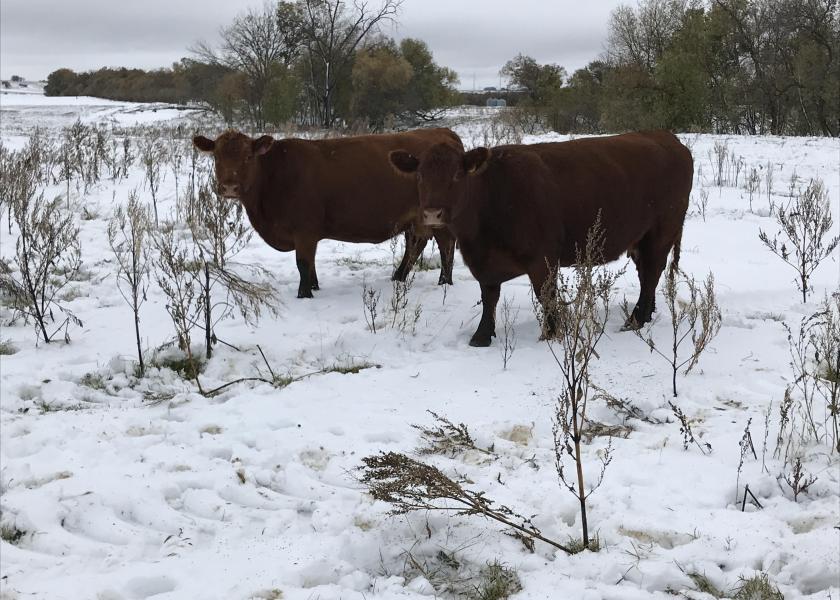Three Common Categories of Pregnancy Losses in Beef Cattle

The three categories of pregnancy losses in beef cattle include early embryonic death, abortion and stillbirth, according to North Dakota State University (NDSU) Extension livestock specialists.
Early embryonic deaths occur within the first 42 days of gestation. After that point, losses are considered abortions. Abortion involves the expulsion of a dead fetus prior to approximately day 270 of gestation, while stillborn calves include full-term calves that are born dead or die in the first 24 to 48 hours after birth.
Abortions are also assumed when females diagnosed as pregnant begin showing signs of estrus (heat) or fail to deliver a calf. Identifying a cause in these cases is more difficult as the only specimen remaining to help determine the cause is a blood sample from the female that suffered the presumed abortion.
“Although pregnancy losses in beef cattle are a fact of life, late-term losses are likely the most discouraging,” says Gerald Stokka, NDSU Extension veterinarian and livestock stewardship specialist. “There are often more questions than answers, and trying to find a reason for the loss can be a complex and frustrating process.”
“Within a herd, a single abortion or stillborn calf may not be regarded as significant,” says Janna Block, Extension livestock systems specialist at NDSU’s Hettinger Research Extension Center. “If several of these instances occur, it is a good idea to investigate further.”
Potential Causes of Losses
Common causes of losses include calving difficulty (dystocia), nutritional deficiencies and infectious diseases.
Dystocia can occur if calves are too big or are not situated normally in the birth canal. Stress and lack of oxygen during calving can result in stillborn calves; however, these losses are often attributed to other causes, Stokka notes. Dystocia and stillbirths are more likely to occur in first-calf heifers because of a smaller pelvic area, and in cows that are either overly conditioned or too thin.
Proper vitamin and mineral intake is also essential for placental and fetal development. In particular, deficiencies of selenium, iodine, manganese, and vitamins A and E may result in abortion.
Some abortions in late pregnancy may be due to injury or extreme stress in the cow due to immune challenges and weather-related issues. The fluid-filled uterus provides good protection for the fetus, but pain or inflammation following maternal injury can cause stress and trigger release of hormones in the body that may initiate premature labor, Stokka explains.
Infectious diseases caused by bacteria, protozoa, viruses and fungi often result in abortions and/or stillbirths in cattle. Vaccines are available to reduce the risk of losses from bacterial diseases including brucellosis, leptospirosis and vibriosis. Diseases such as trichomoniasis, sarcocyctosis and neospora, which are caused by protozoa, can be more difficult to manage because vaccines are unavailable or may be ineffective.
Common viral diseases include bovine viral diarrhea (BVD) and infectious bovine rhinotracheitis (IBR). Vaccines to prevent losses due to IBR and BVD are available and effective; however, producers need to choose their vaccine protocols wisely.
“It is important to always follow label directions when using modified live vaccines in pregnant cows because off-label use may result in abortions,” Stokka says. “To avoid this problem, producers should vaccinate cows when they are not pregnant or consider using vaccines labeled for use in pregnant cows.”
Calf Loss Diagnosis
Laboratory diagnosis of disease issues that contribute to calf losses can be frustrating because the infectious agents often are undetectable in tissue or blood samples. The placenta often is key to obtaining a diagnosis; therefore, submitting the placenta in addition to the fetus whenever possible is very important, Block says.
“Prompt identification of aborting cows and isolation from the herd is recommended to help prevent the spread of infectious diseases if applicable,” she adds. “It is also helpful to have cows isolated in case blood samples from aborting cows are needed to try to identify abnormalities such as mineral levels and/or antibody titers for infectious diseases.”
The specialists recommend that when collecting aborted fetuses and tissues for analysis, producers should be sure to use appropriate biosecurity measures such as latex gloves and a mask to avoid diseases that can be passed from livestock to humans. The fetus and placenta should be placed in a black garbage bag and kept cool until they arrive at the laboratory. Avoid freezing the fetus and/or placenta unless they already were frozen when they were found.
Additional Factors for Determining Loss Causes
Because there are so many potential causes for stillbirths and abortions, it is important to investigate each calf loss individually as well as evaluate the situation on a herd level.
Factors that should be considered when trying to determine the cause of losses include:
- Cow herd nutrition (feed analysis, mineral supplementation program, potential toxicities/deficiencies, etc.)
- Cow’s age and number of offspring
- Vaccination program (types of vaccines used, when administered, etc.)
- Body condition score of cows at calving
- Length of calving, calving difficulty, and whether or not assistance was used
- Presence of any visible abnormalities in the calf
- Cloudy eyes in the calf indicating it has been dead for several hours
“Although diagnosis is not always possible, even with necropsy or laboratory analysis, sample submission to your Diagnostic Laboratory is encouraged if abortion rates are in excess of 1 to 2 percent,” Block advises.







